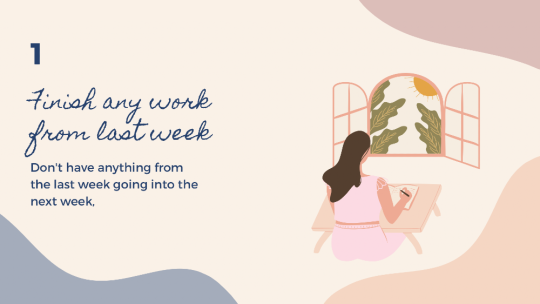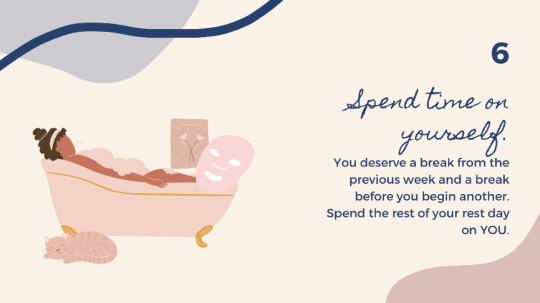Text
College Note-Taking System
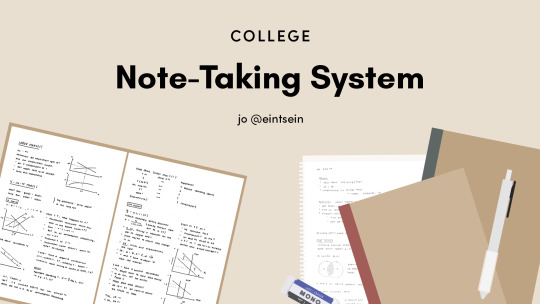
Having cohesive and effective notes is one of the key skills I think one should have, especially in an academic setting. When you’re receiving a ton of information each day, you want to be able to keep track of that and remember what you’ve learned. I’m constantly trying out ways to make my note-taking more effective and tailored to my needs. Here’s what my note-taking system looks like so far.
Quick note: click on the images for better quality!
Class Notes
Taking notes in class is an invaluable way to keep track of the new knowledge you’ve gained. However, depending on the mode in which the lecture material is conveyed, I take my notes differently. Here’s a summary of how I take my notes for each type of lecture, as well as some examples from the classes I’m taking now.
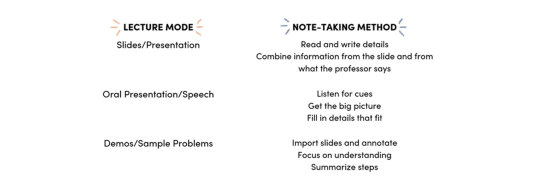
Slides (e.g. Macroeconomics)
Macroeconomics is a class in which you should be able to intuitively understand a lot of concepts but also remember a lot of things. Because of this, I’ve tailored my note-taking method and habits to achieve that goal.
I write my notes by hand because handwriting is more effective in committing things to memory.
As for what I actually do - and this is what I’ve done for other classes in which the professor/lecturer uses slides:
Read/skim over the slide.
Read each bullet point as the professor goes through them.
Copy it down if it’s straightforward or write it down in a structure and diction that I understand better (not necessarily in my own words - sometimes it’s just restructuring, e.g. splitting things up or joining different bullet points together).
Take note of any other important details the professor says about any particular point unless I think it’s intuitive or common sense.
Here’s an example from a Macroeconomics lecture.

Oral Presentation (e.g. Anthropology)
During classes in which the professor just speaks and doesn’t use much visual material, I listen before I write instead of attempting to write down every single detail mentioned.
Also, I type up my notes instead of handwriting them since the exams are all open-book so I don’t really have to commit things to memory.
Here’s what I do:
Listen for a cue that tells you what this particular part of the lecture will be about (and write it as a heading).
Write down main ideas and their supporting facts/details. If the facts/details come before the main ideas, then I’d usually draw an arrow.
Write down ideas and details from readings in their own section/subsection.
Sometimes, my professor also shows short clips in class, in which case I’d write down the message that I think the clip was meant to convey, as well as things that the professor points out that I didn’t think of on my own.
I’d also look up concepts/ideas/people/events (in real time) that are important to my understanding of the lecture material.
Here’s an example of a Google Docs document from an Anthropology lecture.

Demonstrations and Sample Problems (e.g. Computer Science)
Classes in which the lecture is mainly going through demos and problems are kind of tricky, because you want to know and understand what the professor is doing, but you also don’t want to be writing down every single step that’s being executed. Here’s what I’ve found to be the most effective so far:
If there are any, I import the slides/handout onto OneNote and annotate directly on the slide. If not, I just write down things like definitions, important concepts, and syntax-related things.
I focus on understanding what the professor’s doing with the demo or problem.
I then summarize the steps they took and
Write down comments and points they brought up, e.g. common errors, desirable habits/practices.
Also, these kinds of classes are usually classes in which you’d learn better when you actually do problems yourself, so I definitely learn more when I do assignments and labs than when I’m in class.
Here’s an example from a Web Programming lecture.

Here’s one from an Object Oriented Programming and Data Structures class. I often draw things to help me visualize the general points.

Rewritten Notes
My rewritten notes have definitely changed a lot since high school. Since most of my classes don’t require a lot of memorization, I organize my notes in such a way that they’d be easy to index or find information from. Here are some of the ways I do that:
Establishing a Visual Hierarchy
Having a well-defined hierarchy helps me flow through my notes really well as i read them. It helps me organize information like a mind map without actually making a mind map - I know the big topics and their subtopics and sub-subtopics and details … basically it’s easier to see how these ideas fit together.
But why don’t I just make mind-maps? See, the thing is, a lot of my notes require sequential or linear thinking, e.g. in macroeconomics it might be the sequence of events following a change in the economy, or in computer science it might be a general algorithm for solving a certain type of problem, or it might be proving or deriving a certain equation. These sorts of things just generally don’t work well with mind maps. Instead, establishing a visual hierarchy in my notes helps me organize different ideas while retaining the linear nature of the information.
Here’s what the hierarchy looks like.

Here is an example from my Web Programming class, which is a purely project-based class, so no prelims or exams. As you can see, I draw rectangles around important terminology so that I can easily find them while I’m working on a project. I also include examples from in-class activities as well as notes on syntax so I have an idea of how to implement certain things. These examples and notes are further grouped by terminology/concept.
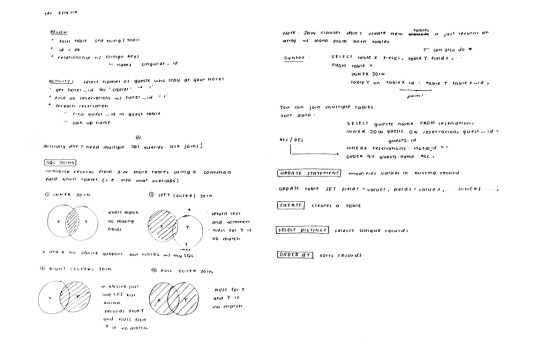
Structuring Them for Easier Flow
My syllabi for my college courses are nowhere near as detailed as the syllabi for my high school courses - those of you who take/have taken Cambridge exams would know. In college, my syllabi are only lists of topics and not what you’re expected to know for each topic. Because of this, I have to find a way to arrange information so that I can achieve the most comprehensive and cohesive understanding of that topic, i.e. so that the flow of my notes is similar to the flow of my thinking.
For example, in my economics notebook, I like to have the details first (e.g. the separate markets: the goods market, the assets market, and the labor market) and then the big picture later (IS-LM-FE). Some people prefer the other way around - seeing the big picture and then going into the details - which I can understand and have done myself for certain topics.
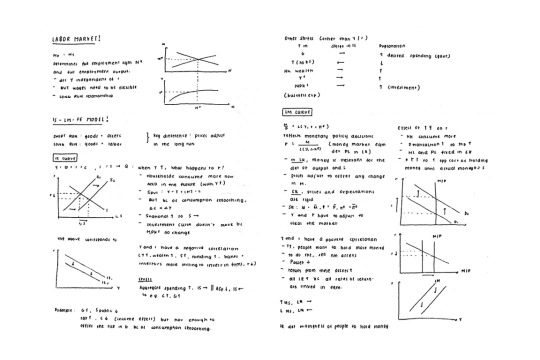
Making Use of Proximity and Spacing
I very much dislike notes without good use of spacing and grouping things together. Keeping related ideas in visual proximity helps your brain (or at least mine) organize this information. It’s also a lot easier to find things and visualize your notes when they’re not just a huge chunk of text.
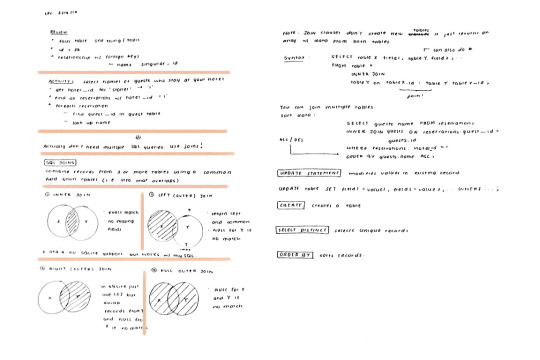
One thing I should probably mention is that I don’t use colored pens anymore because it just takes a lot of time to switch pens and think of a color palette. I also don’t have much use for it. In the past, I used color to help me memorize and group things in different categories, but now, I’ve found that there aren’t a whole lot of categories I need to keep track of, and when I do, I can do so with just one pen but changing the style of the text.
And that’s what my note-taking system currently looks like. It’s working well so far, but I still think there are other things I could try out that might be a better fit.
So yeah, hope this was helpful, and as always, feel free to drop an ask if you have any questions, or even if you have any suggestions or would like to share your note-taking system. Have an awesome week!
10K notes
·
View notes
Text
About Productivity Grids
I’ve seen more and more people starting to use the productivity grids I’ve been using this year to track my progress (which is awesome), along with concerns about them being toxic and putting the focus on “filling in the grid” rather than actually being productive. So! I thought I’d make a post about how I use them and how to avoid that icky feeling that you’re not being “productive enough”.
What is a productivity grid?
Here’s an example of my productivity grid from this week:

As you can see, I split my different areas of productivity into subsections and mark each day I do them. I fill it in each week, then I take a screenshot to post to my language learning log before clearing it out and filling it in again the next week.
A lot of people use powerpoint for their grids. I use excel with conditional formatting (so I just pop an ‘x’ or ‘/’ in a box and it automatically changes colour, which is super exciting for my dumbass monkey brain). You can use whatever works for you though - I used to print out tables and put gold stars in each square I completed.
What it’s good for
This grid is great for keeping track of things. You can therefore use it to:
See which areas you’ve been working on and which ones you’ve been neglecting. This is a major one for me, because I would go for literally months without doing any speaking practise and only realise when I went back through my blog to find that one recording of me speaking. Now I can see at a glance if I’ve done any speaking practice this week, or last week. All in all, it helps me balance my studying a lot more.
Help you decide what to work on next. Sometimes I get a bit overwhelmed by the choice of what to study. Do I pick up my grammar book? Do I watch the news in my TL? Do I read my book? So then I’ll look at my grid and think “well, I’ve been doing a lot of reading this week but I’ve not spent any time on grammar, so I’ll do that.”
Make sure you’re taking care of yourself. Before I used these for studying, I had a similar grid for self-care, which I filled with things like “went for a walk” and “ate three meals” and “had at least one vegetable” and “read a book” and “talked to a friend”. You can see I’ve included some elements of that in this grid, and honestly I think this is very very important to include.
Understand and predict burn-out. It’s quite easy to see if you’ve been overworking yourself. If you have a lot of full squares one week and a lot of blank squares the next, you can think to yourself “huh, maybe I worked too hard and that wasn’t good for me, clearly I need more balance.”
And of course, it does provide some motivation for yourself if, like me, you love things to be super colourful. Do I sometimes push myself to do a thing just because I want extra colour on my spreadsheet? Yes, absolutely.
Limitations
If you’re looking at this and thinking “I should do that so that I keep myself accountable to my followers”, then I highly recommend you do not use this method. If you do, keep it in a word document for yourself. The goal is not to threaten yourself with a blank grid of shame. The goal is, as I said before, to keep track of things for your own benefit.
Additionally, this only provides quantitative data, and doesn’t give any indication of how much you did. If you spend thirty minutes on an essay every day for a week, you’ll fill more squares than if you spend 5 hours on that essay in one night. Even though you actually spent more time on it, you would seem less “productive”. That’s why I always use it alongside a written log.
Another thing is that there are always situations you don’t account for that don’t fit on the grid. Spent all day cheering up your best friend after her boyfriend broke her heart? Yeah, that’s not gonna show up, so you might end up with a whole day that’s blank.
Some tips for using productivity grids
Be flexible! I’m always swapping my grids around to reflect what I’m working on. I used to have full grids for Icelandic and Finnish, but they took more of a backseat so I shrunk them down to fit in alongside Japanese. You can always add in more grids or take ones out.
Use it to track “unproductive” activities too (if you want). I cannot stress this enough: self-care counts as productive! Cooking yourself a nice meal is productive. Choosing to watch a Disney movie because you’re tired and the thought of studying makes you want to cry is productive. Calling your friend and admitting you’re not okay is productive. Spending time on your hobbies is productive (languages and writing are a hobby for me, so like 70% of my grid is actually devoted to hobbies). Of course, if you then feel like you’re forcing yourself to do your hobbies just to fill in an extra square, take that line out.
Keep a written log of your feelings and accomplishments. In my language log I talk about how well I feel I understood things, how tired I’ve been feeling, what I’ve struggled with and what I’m proud of. This will give more context to your grid, as well as help with identifying those patterns we talked about earlier (if I’m feeling tired and nothing’s working and I notice I’ve not been exercising, I can try the following week to exercise more and compare how I feel).
Never aim for a full grid. You should always have blank spaces - you can’t do everything all the time! If you find you’re consistently filling everything in, you might need to evaluate whether your habits are healthy.
If there are consistently a lot of blank spaces in a particular area, evaluate why. Are you not doing any writing because you’re uninspired? Anxious? Are you just focused on something else right now? Is it so important to you that you do it? Have a think about the reason and whether it’s something that needs addressing or not. (My writing grid is often blank or nearly blank, but that’s fine because it’s not something I want to pursue professionally. My stretching/performance grids being as blank as they are though, well, that is a problem that I need to address.)
If you’re not sure whether something “counts” or not, add levels to it. See how I have some boxes marked with a / instead of an X with a lighter background? Those were when I told myself “this doesn’t really count”. I only stretched when I warmed up, I only spoke a few broken sentences to myself, I did half a Duolingo lesson then quit etc. For a long time, I didn’t mark them in at all. Now I do because I was getting too harsh on myself. You could always try ranking your sessions based on how intense/productive they were, or putting in numbers to show how much time you spent on them. This doesn’t work for everyone though and can add further pressure.
Remember your followers appreciate honesty. Like I said earlier, you don’t have to post these to tumblr; you can keep them for yourself (either in a word document or a spreadsheet or print them out etc). But if you do post them, remember that giving your followers an unhealthy impression of always being productive won’t do them any favours. So embrace those blank squares and don’t feel ashamed.
If you start to feel anxious about how “little” you’re achieving, or like it’s preventing you from being truly productive, stop using it. No method works for everyone and you should never feel pressured to continue using a method that doesn’t work for you just because other people on tumblr do it (just like I never take aesthetic pictures because spending all that time and effort setting them up burns me out before I’ve even started).
Happy studying, everyone! Go smash those goals and remember to look after yourselves while you do it.
311 notes
·
View notes
Text
Graduate Studies, Week 4
Most of my classes got rescheduled for reasons, so I had a lot of time on my hands. Planned a little weekend getaway with my friends from college and work. A night camping by the beach under the stars and then sigh seeing the morning after. Much needed mini-adventure!



#pakistan#tourism#weekend#getaway#explore#adventure#friends#work#beach#mountains#hills#canyons#water#shore#camping#camps#lights#stars#galaxy#stargazing#fun#memories#personal#balochistan#scenic#art#traveling#trip#tour
1 note
·
View note
Text
- ̗ ̀ study break ideas ̖ ́-
if you have 5 minutes...
watch a TED talk
light a candle
paint your nails
put on a hair/face mask
splash your face with cold water
walk around your house
stretch
have a small snack
make a cup of tea/coffee
clear your desk
if you have 10-15 minutes...
watch a longer TED talk
watch a youtube video on studying/something educational
do some yoga
go for a quick run
have a shower
make a smoothie
power nap
workout
organise your desk
if you have 20-35 minutes...
watch a longer TED talk
watch one short episode of a tv programme
do a longer workout
go for a longer run
go for a walk
bake something
call a friend
if you have 40-60 minutes...
watch a documentary
watch one longer episode of a tv programme
go for an even longer walk/run
have a bath
have a one hour nap to help you remember things
8K notes
·
View notes
Text
Graduate Studies, Week 3
I'm trying to participate in class more actively than I did in undergrad. It's still just as daunting, maybe even more, because my class has some pretty qualified, kickass professionals from very diverse backgrounds.
I've learned that in most cases, I know the answer but cant work up the nerve to speak it out loud, which is purely driven by my fear of failure. And when I do participate, my social anxiety flares up. I begin zoning out of class and hyperfixating on how others might perceive me now that they know how I think.
Sucks when that happens doesnt it? I'm sure a lot of you can relate.
Anyway, here's a photo of my campus that I took before my class on Saturday

#graduate#grad#mba#university#college#girl#studyblr#study blog#new study blog#bujo#morninggrind#planning#study#studying#log#planner#campus#campus life#covid#masters#business#administration#engineering#studies#confidence#class#class participation#social anxiety#anxiety#nervous
5 notes
·
View notes
Text
Amen❤❤
Life update: I started my MBA this week!
I have a bachelor's degree in engineering, but I have decided to pursue a degree in business to diversify my profile. Honestly it's been a little shaky because I'm having a hard time catching up with the management lingo. But honestly, I'm also pretty enthusiastic to learn new things right now. Might not have the same thoughts during finals. We'll see I guess lol
If you're reading this, send a little luck my way pls I need it!
8 notes
·
View notes
Text
Life update: I started my MBA this week!
I have a bachelor's degree in engineering, but I have decided to pursue a degree in business to diversify my profile. Honestly it's been a little shaky because I'm having a hard time catching up with the management lingo. But honestly, I'm also pretty enthusiastic to learn new things right now. Might not have the same thoughts during finals. We'll see I guess lol
If you're reading this, send a little luck my way pls I need it!
#personal#study#studyblr#bujo#log#planner#studying#study night#planning#blog#study notes#study motivation#motivation#mba#masters#graduate#diary#daily#notes#college#degree#colleges#Pakistan
8 notes
·
View notes
Photo
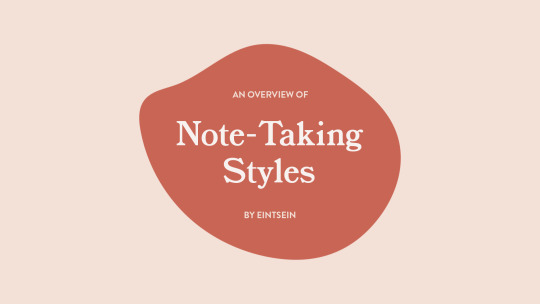

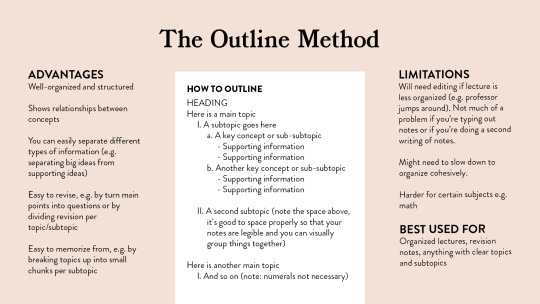


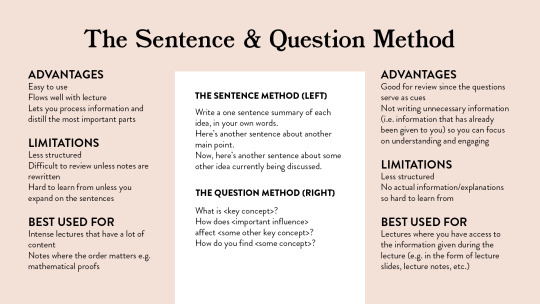



An Overview of Note-Taking Styles
Note-taking is one of the most essential skills a student should master. It allows you to record and review information to be used in the future. But what’s the best way to do so? Here’s an overview of note-taking styles that can help you maximize your learning!
56K notes
·
View notes
Text
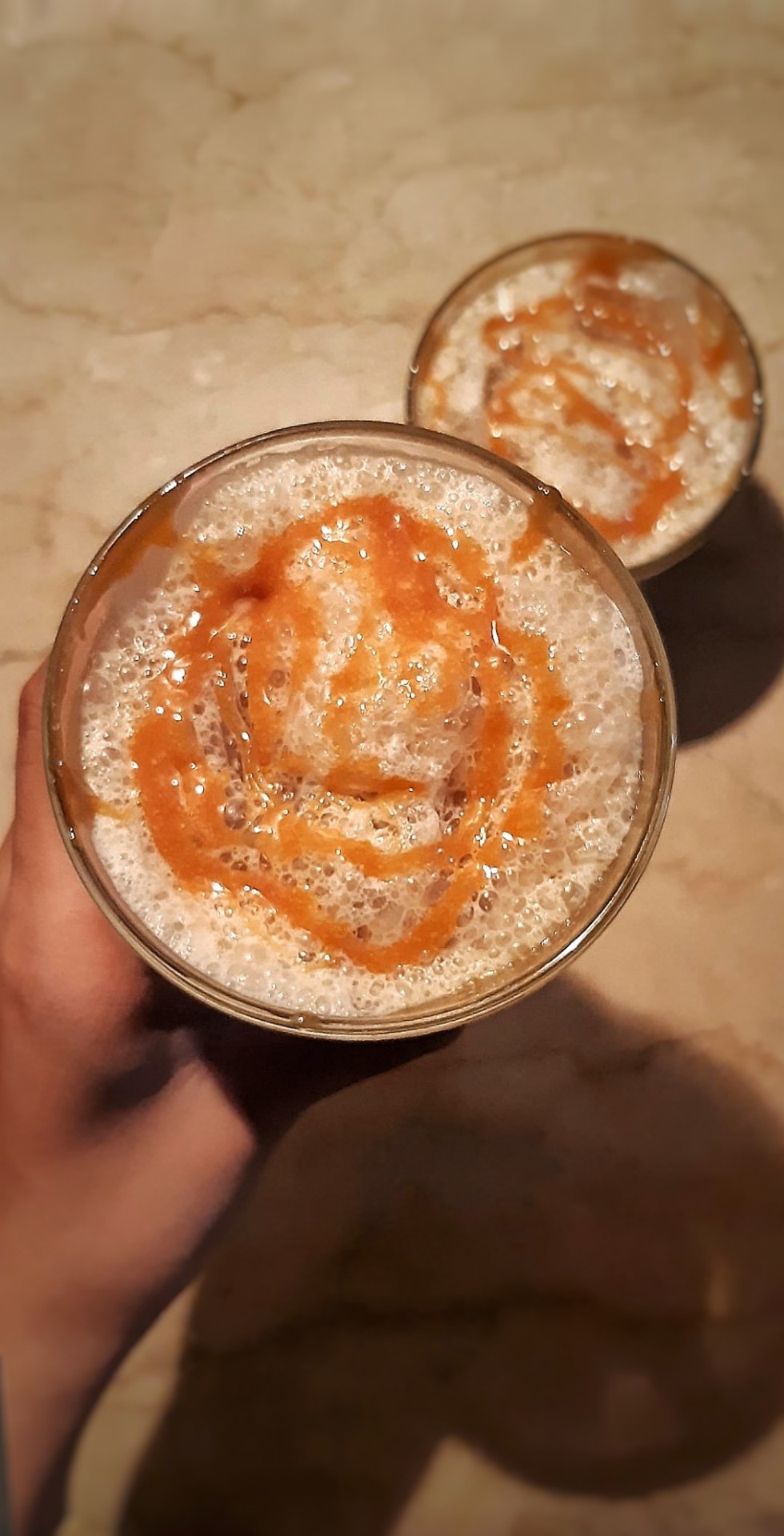
One thing that I've worked up the nerve to do during these "unprecedented times" is experiment in the kitchen. I used to be so afraid of screwing up and feeling like a failure that I almost never tried anything new.
Anyway here's my first attempt at a caramel frappuccino
#caramel#frappuccino#love#drink#coffee#breakfast#iced coffee#latte#rain#coffeeholic#summer#studyblr#study blog#workblr#work from home#quarantine#stay home#study motivation#study notes#studying#food#bujo#log#planner#planning#study#morninggrind
6 notes
·
View notes
Text
a reminder for fellow students to be realistic about their productivity. real life will get in the way - trains get delayed, books will be on loan, classes are rescheduled. take a deep breath and problem-solve. adapting to the situation is not failure, but we are setting ourselves up for failure if we leave no room for it.
10K notes
·
View notes
Text

My first attempt at pancakes. Dad thinks they're basically parathey for non-desis and ngl I feel the same way
#breakfast#morning#goodreads#good morning#eggs#pancakes#food#foodphotography#foodlover#foodpics#healthy food#chai#butter#milk#honey#morninggrind#weekend#bread#bake#cook#love to cook#lets cook#studyblr#workblr#workfromhome#work from your phone#workfromanywhere#study#grind
2 notes
·
View notes
Text
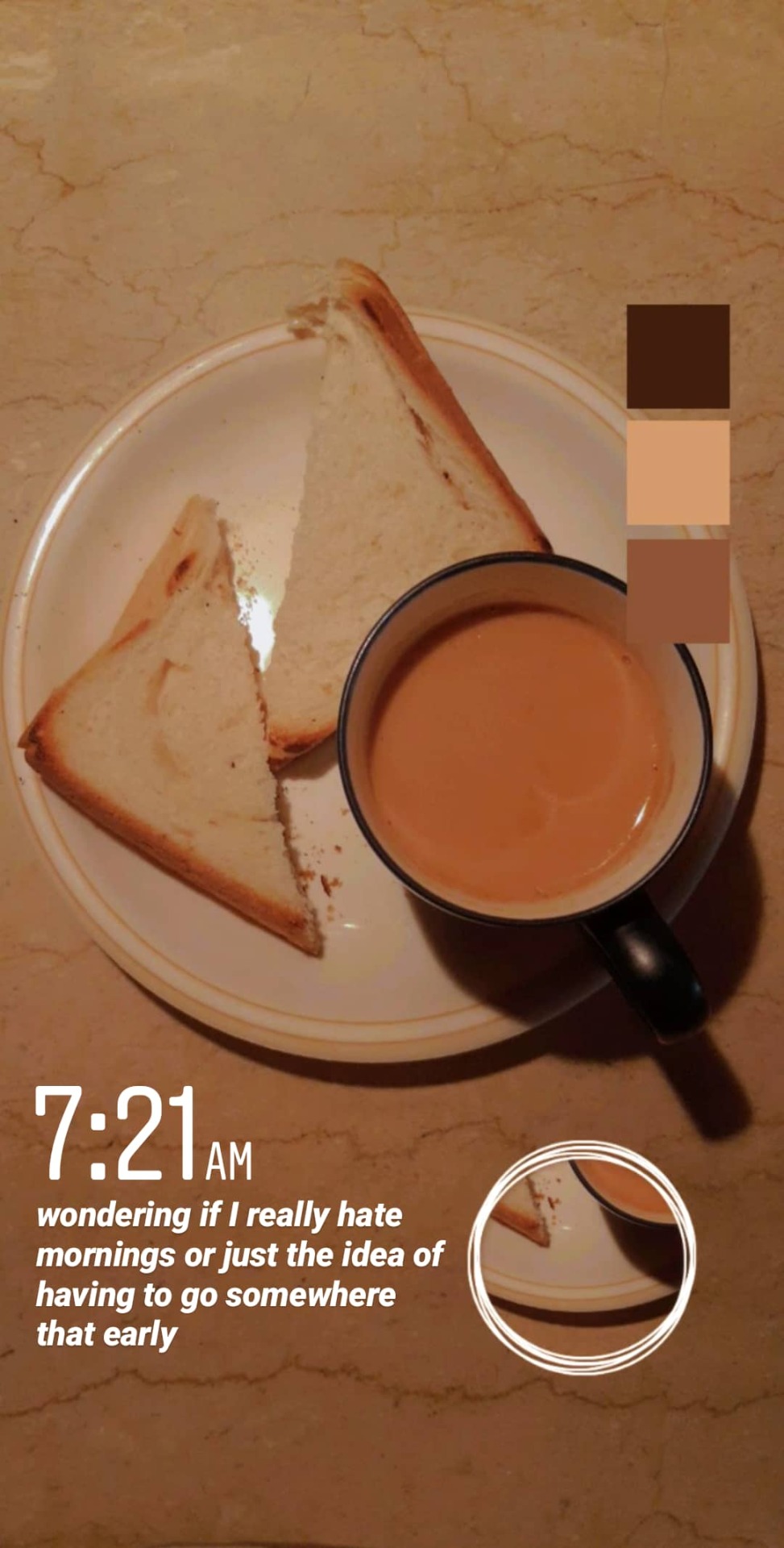
#morning#breakfast#studyblr#workblr#workfromhome#tea#planner#bujo#planning#love#log#daily log#toast#sandwich#morninggrind
15 notes
·
View notes
Text
I'm so frustrated with myself I've been working on this presentation for days and I'm still no where near being satisfied with how it looks. Why do I make these small tasks appear huge to myself and then end up in a spot where I cant move anywhere!!!
1 note
·
View note
Text
“I didn’t realize it, but the days came along one after another, and then two years were gone, and everything was gone, and I was gone.”
— F. Scott Fitzgerald
4K notes
·
View notes
Text
for as much as studyblr may have its faults, it’s a pretty sizable online space that tells young girls that the absolute coolest thing you can do is be smart and work hard and believe in yourself and i think that’s pretty great
16K notes
·
View notes

